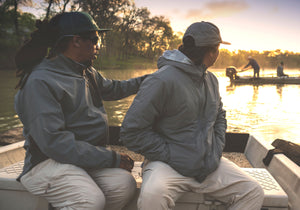Catch and release fishing is not just a method but a philosophy that underscores a commitment to conservation and ethical sportsmanship. This is something we are very passionate about. With the growing popularity of fly fishing across the UK and beyond, adopting best practices for catch and release ensures that we are preserving fish populations and their habitats for future generations.We'll explore best practices for catch and release in fly fishing, as this is important for ensuring that anglers are equipped with the knowledge to fish responsibly and sustainably.
What is Catch and Release?
Catch and release fishing is a practice where fish are carefully caught and immediately released back into their habitat. The goal is to minimise the mortality rates of the fish, which can be significantly impacted by how they are handled from the moment they are hooked to when they are released back into the water.
Why Practice Catch and Release?
By releasing fish back into their natural environment, anglers contribute to the health of fish populations, maintaining ecological balance and ensuring that future anglers can enjoy the same experiences. Practising catch and release is also a legal requirement in areas where fish populations are threatened or under conservation.
Best Practices for Catch and Release in Fly Fishing
Use the Right Equipment
- Hooks: Employ barbless hooks or pinch the barbs on your hooks flat. Barbless hooks cause less damage to the fish, making them easier to remove and reducing the injury to the fish.
- Nets: Use a net made of rubber or coated mesh. These materials are gentler on the fish’s skin, scales, and mucus coating than traditional nylon nets, which can remove protective slime and scales.
- Rods and Lines: Choose a rod and line weight appropriate for the type of fish you are targeting. This ensures that you can handle the fish quickly and reduce the duration of the struggle, which is crucial in minimising stress and exhaustion in the fish.
Handle With Care
- Wet Your Hands: Always wet your hands before handling fish. This practice helps to protect the fish’s slime coat, which is vital for their protection against infections and parasites.
- Keep the Fish in Water: Minimise air exposure as much as possible. Research suggests that fish exposed to air for more than 30 seconds significantly increases their mortality risk.
- Gentle Handling: Support the fish gently with both hands, one on the tail and the other under the belly. Avoid squeezing the fish or touching its gills.
Efficient Release Techniques
- Revive the Fish: If the fish appears exhausted or lethargic, hold it upright in the water, gently moving it back and forth to enhance water flow through its gills.
- Choose Calm Water for Release: Release the fish in calm, shallow water away from strong currents. This allows the fish to regain its strength gradually.
- Observe After Release: Watch the fish after release to ensure it swims away strongly. If it struggles, it may need more time to recover.
The Ethics of Fly Fishing
Ethical fly fishing also encompasses a respect for the environment and the species within it. This includes knowing and following local fishing regulations, respecting other anglers and property owners, and participating in local conservation efforts. Being an ethical angler means continuously educating oneself about the ecosystems and the impacts of one’s actions on the environment.
The Role of Anglers in Conservation
Anglers play a critical role in aquatic conservation. Through practices like catch and release, anglers help to maintain fish populations and serve as stewards of the waterways. Engaging with local conservation groups and initiatives, participating in habitat restoration projects, and spreading awareness about sustainable practices are all ways in which anglers contribute to the broader conservation efforts.
Understanding Local Regulations and Seasons
Know the Rules
Before heading out to your fishing spot, it's crucial to familiarise yourself with the local fishing regulations. These rules can vary significantly by region and water body, covering aspects such as:
- Species: Some species may be protected and require immediate release if caught.
- Fishing Seasons: Many areas have specific seasons for fishing to protect fish during their spawning period or to manage population health.
Adhering to these regulations is not only a legal responsibility but also an ethical one. Regulations are typically based on scientific studies aimed at sustaining fish populations, and following them helps ensure the health of the ecosystem.
Seasonal Considerations
Understanding the seasonal behaviours of fish can also enhance your catch and release practice. For example, during spawning times, fish are more vulnerable and may require gentler handling and quicker release to minimise disruption to their reproductive process. By aligning your fishing activities with the natural cycles of the environment, you contribute further to conservation efforts.
Promoting Ethical Angling Through Education and Community Engagement
Engage with the Angling Community
Participating in or even initiating community events related to fly fishing can be a great way to spread the word about ethical practices. Workshops, seminars, and informal meet-ups can provide education and foster a community spirit dedicated to sustainable angling.
Mentorship and Sharing Knowledge
Experienced anglers have a wealth of knowledge that can be invaluable to novices. By mentoring new anglers, experienced individuals can directly impact ethical practices and personal insights that promote conservation-minded fishing. Sharing stories, techniques, and best practices through social media, blogs, and community forums can also influence a wider audience, encouraging a collective movement towards more responsible fishing.
Support Conservation Initiatives
Many fishing equipment brands and local businesses support conservation efforts through funding and resources. Purchasing products from companies that actively contribute to conservation can make a significant difference. Additionally, anglers can join or support organisations that focus on habitat preservation, pollution control, and educational programs about the ecological impact of fishing.

